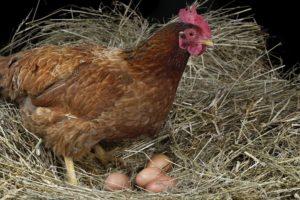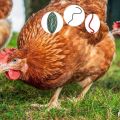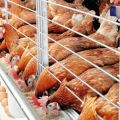Duration of daylight hours for laying hens in winter, rules and lighting regime
The length of daylight hours for laying hens in winter is of great importance. This parameter affects productive birds. With the help of the duration and intensity of lighting in the chicken coop, it is possible to regulate the development of birds, provide them with good rest, and control the quantity and quality of eggs. Therefore, it is so important to properly organize the lighting system of the house. It must be not only effective but also safe.
What does light affect
Regardless of seasonal factors, it is recommended to accustom chickens to stable lighting from the very beginning. Bird egg breeds begin to lay at 4 months. In meat breeds, this occurs in six months. It is impossible to constantly maintain bright lighting.
Intensity
Chickens see poorly in the dark, but depend on the intensity of light. They are more sensitive to this indicator than mammals.
Depending on the light intensity, the brain sends impulses to organs and systems. They affect sleep, development, appetite, breeding. This means that most of the physiological processes in the body of chickens can be regulated with the help of light.
In sunny weather, experts recommend shading the chicken coop. Excessive light not only negatively affects productivity parameters, but also leads to pecking of eggs. Too intense illumination provokes cannibalism, aggressive behavior, high invasiveness of birds.

Daylight hours
The length of daylight hours affects many processes - first of all, the quantity and quality of eggs. The following features depend on this indicator:
- weight and size of eggs;
- the process of development and maturation of chickens;
- shell thickness;
- bird health;
- rest of birds;
- metabolic processes;
- weight of chickens.
In this case, the light should be turned off at night. Excessive use of lamps has negative consequences.

Pros and cons of different types of lamps
Different types of lamps are used to illuminate the chicken coop. Each of them has advantages and disadvantages.
Incandescent lamps
This is the most affordable and environmentally friendly option. Incandescent lamps are easy to use. They have a simple design, are easy to change and are used to heat the room. In addition, such products provide good illumination.
Incandescent lamps can be used in cold rooms. They are used for spot heating. Thanks to such devices, it is possible to heat the cages with chickens. The downside is a short service life.

Fluorescent Lamp
This is a great option for a chicken coop. Such lamps are considered to be a source of even white light. They are reliable and durable. The cost of such models is relatively low. Moreover, they are considered very economical. The disadvantages include the need to dispose of devices.

Energy saving lamp
Such devices allow to reduce energy costs and obtain the required spectrum of lighting. The disadvantage is the high cost. In addition, mercury is present in such devices, so they must be properly disposed of.
In a chicken coop, such lamps often last less than the required period. At the same time, the ability to adjust the illumination allows you to minimize the stress of birds during capture.

LED lamp
Such lamps are characterized by a long period of operation - more than 50 thousand hours. Today, there are special versions of LED devices that are used in poultry farms. Such models are easy to use. They function at different temperatures.
In addition, LED lamps are economical, resistant to high humidity and dirt. They allow you to control the intensity of lighting, which is important in a chicken coop. The disadvantage of such devices is the high cost, but they pay off quickly.

How to properly equip a lighting system in a chicken coop
To achieve good results in arranging a lighting system in a poultry house, it is worth reading the recommendations in advance.
How to calculate the brightness of light
The lighting in the room where mature birds live should be at the level of 10-15 lux. For parent stock, this parameter should be at least 15 lux. At these rates, the males are the most active.
It should be borne in mind that lighting over 20 suites is dangerous. It can cause the birds to be highly aggressive.

Lamp color
The shade of the lamp affects the behavior of chickens:
- blue - has a calming effect and reduces the symptoms of aggression;
- blue-green - provides fast maturation of young animals;
- orange - stimulates puberty in chickens;
- red - copes with the manifestations of aggression and symptoms of cannibalism, but at the same time reduces productivity.
In most cases, farmers use white light bulbs. In this case, the flickering effect should not exceed 26000 Hertz. Higher rates negatively affect bird vision.
Installation locations
The lamps should be placed in such a way that a person does not touch their head when entering the chicken coop. At the same time, he should easily reach the lamps with his hand in order to replace them or repair them. The average ceiling height is 1.8-2 meters.
It is advisable to cover the lamps with shades, which will provide protection from dust and water. It is important that the protection is strong. Otherwise, birds can accidentally damage the lamps.
When conducting lighting, it is worth minimizing the use of cable. A damp floor and other unfavorable factors can provoke a short circuit. This poses a danger to the life of birds. It is recommended to install the shield outside the premises.
When keeping birds in cages, wires should be placed above the batteries. When placing feeders in cages, it is worth using additional sources of lighting inside.

When to include
In winter, it is recommended to turn on the lamps early and turn them off late.
As a result, chickens should have 14 hours of continuous lighting.In this case, it is important to ensure that there are no sharp fluctuations when switching the light sources on and off. This will help the birds to synchronize with the regimen and establish metabolic processes within the format.
It is advisable to use a timer in the chicken coop. This will help make life easier for the farmer. Experts advise choosing the simplest models for small chicken coops. The device is plugged into an outlet and connected to the wiring. Then it is worth choosing the optimal program.

Development of lighting programs for chickens of different ages
For broilers and layers, it is recommended to choose the right lighting mode. In this case, it is worth considering their age:
- on the first day of life, 1 hour of darkness is required;
- after reaching a mass of 150 grams, it takes 9 hours of darkness;
- chickens 22 days old require 8 hours of darkness;
- 23-day-old birds are set to 7 hours of darkness;
- 6 hours of darkness are required at 24 days;
- 1-5 days before slaughter, chickens need 1-6 hours of darkness.
The duration of daylight hours affects the physiological processes of birds. To increase their productivity, it is recommended to choose the right intensity and duration of illumination.









